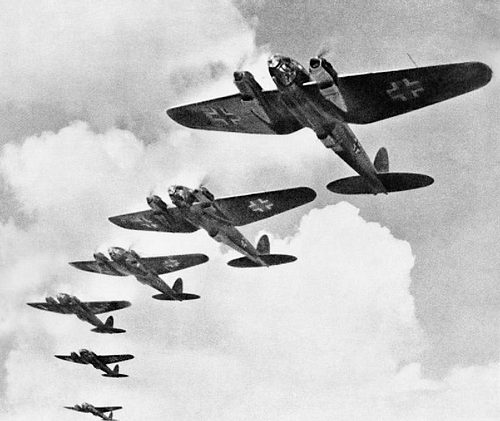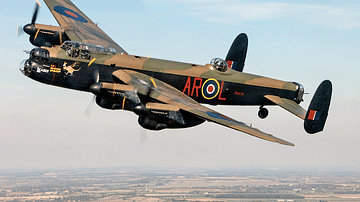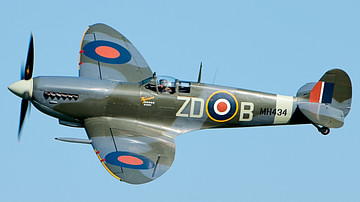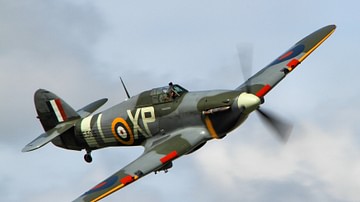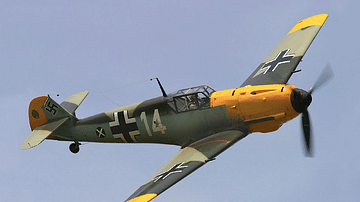
The Heinkel He 111 was a medium two-engined bomber plane used by the German Air Force (Luftwaffe) during the Second World War (1939-45). Heinkel He 111s contributed significantly to such campaigns as the Battle of France, the Battle of Britain, and the London Blitz, but were increasingly replaced from 1941 by the more modern and faster Junkers Ju 88.
Early Designs
The He 111 was first imagined as a civil airliner for Lufthansa, but when the Nazis came to power in Germany in 1933, production turned more openly towards machines of war. The Treaty of Versailles after the First World War (1914-18) had strictly forbidden Germany from possessing a military air force, but the German leader Adolf Hitler (1889-1945) went ahead and formed several secret squadrons anyway. Another way around the restriction was to build civilian craft that could easily be converted into bombers; the He 111 fell into this latter category.
Designed by Siegfried and Walter Günter and based on their earlier He 70 model, the He 111 bomber was manufactured by Heinkel, an aviation company founded and run by Ernest Heinkel (1888-1958). Heinkel had extensive experience with military aircraft, having built planes for the German Navy and the Austro-Hungarian army in the First World War. After much debate between the German high command and Hitler, the Luftwaffe bomber command (Kampfwaffe) was obliged to adopt the position that bombers should primarily be used strategically to assist ground troops. This meant that unlike, say, the British Royal Air Force, the Luftwaffe concentrated not on heavy bombers but building squadrons of more versatile medium bombers. The He 111 was the result of this thinking, that is, an aircraft with multiple tactical uses, but one not capable of carrying very heavy bomb loads that could deliver a significant blow to ground targets. The He 111 was hampered, too, by its short range as the theatre of war expanded and Germany sought to bomb Britain.
The first He 111 prototype model was flown in February 1935 at the Heinkel works at Rostock-Marienehe (now Rostock). Design tweaks included shortening the wings and improving stability. At this stage, the aircraft were powered by BMW engines. By 1936, Lufthansa was flying a number of He 111s as airliners and transport planes. The aircraft achieved the title of 'the world's fastest passenger plane' when a top speed of 250 mph (402 km/h) was recorded.

Meanwhile, military versions were being built, which had a slightly longer nose and machine-gun armaments. The bomber version was not powerful enough for requirements, though, and the BMW engines were replaced with Daimler-Benz engines (later models replaced these again, this time with Junkers Jumos). By 1937, and thanks to a large ministerial order, Heinkel built a dedicated factory for He 111s at Oranienburg close to Berlin. Further developments followed such as increasing the fuel capacity and making the tanks self-sealing, increasing the armour protection, making a straighter wing so that factory production was more efficient, moving the forward gunner a little to the side to give the pilot better visibility, and giving more transparency to the cockpit area and nose section, a distinctive feature of the He 111.
Heinkel He 111s were first used in action by German forces participating in the Spanish Civil War (1936-9) in the Legion Condor units and then throughout the Second World War by the Luftwaffe. Other air forces which used He 111s included the Chinese, Hungarian, Romanian, Slovakian, Spanish, and Turkish.
Specifications
A Heinkel He 111 measured almost 54 feet (16.5 m) in length and had a wingspan of just over 74 feet (22.5 m). He 111s were powered by two Junkers Jumo 12-cylinder engines capable of 1,350 hp (1007 kW). The bombers had a top speed of between 225 and 260 mph (365 to 420 km/h). Their service ceiling was 21,980 feet (6,700 m), with a range of up to 1,200 miles (1,950 km). The aircraft could carry a bomb load of up to 5,500 lb (2,500 kg), although the standard load was 4,400 lbs (2,000 kg). Incendiary bombs included the 2.2-lb (1-kg) Elektronbrandbombe (electron incendiary bomb), which was usually dropped in clusters of 36. Special-size explosive bombs included the 2,200-lb (1,000-kg) 'Hermann', affectionately named after Hermann Göring (1893-1946), the portly head of the Luftwaffe. There were also the 'Satan' (4,000 lb/1,800 kg) and 'Max' (5,500 lb/2,500 kg) bombs. All of these bombs were cylindrical in shape and so known as Sprengbombe Cylindrisch. The larger versions so affected the aircraft's manoeuvrability that specialised crews had to be used for their deployment. Larger bombs also required the He 111 to be fitted with external racks, an addition that could be used on other occasions to carry additional missiles and torpedoes.
A typical He 111 crew had five members: a pilot, a navigator, a bomb-aimer (who doubled as the nose-gunner), a gunner in the ventral gondola, and another gunner in the dorsal position. The He 111's defences included a 13-mm (0.51-in) MG 131 machine gun, three 7.92-mm (0.31-in) MG 81Z machine guns, and a 20-mm (0.78-inch) MG FF cannon. These weapons were located in the nose (the cannon), dorsal, and belly positions of the aircraft. The ventral gondola could have both a front- and rear-facing machine gun in some models. Some models also had a fixed machine gun in the tail. These armaments, though impressive for the 1930s and capable of firing off a magazine of 75 rounds in just 4.5 seconds, proved insufficient protection against the enemy fighter planes of 1940 onwards. The undercarriage gun placement was particularly vulnerable since fighters often attacked from below; it became known as the Sterbebett ('Deathbed') by the gunner crews.
Navigational Aids
Bombing was a far from accurate operation for all sides in the early years of the Second World War. The Luftwaffe did employ various technological devices to assist navigators to reach their targets and bomb-sighters to drop the loads at the correct position. There were radio beacons spread across the European continent to aid navigation, although the British interfered with these by sending out masking signals known as Meacons.
Knickebein ('Crooked Leg') navigation beams were in operation from December 1939. These were two radio signal beams sent across and from Continental Europe (France, the Netherlands, and Norway) which the bombers could track. One beam sent out dot signals and the other longer dash signals. Where the two beams crossed marked the place where the bombs should be dropped. Thanks to military intelligence, the British knew of the system from the spring of 1940, and jamming of it began in August with a device code-named 'Aspirin' (since Knickebein was a real headache for the defenders).
Heinkel He 111s and other bombers could be fitted with X-Gerät (X-apparatus) radar equipment, which followed several beams sent by transmitters in Continental Europe. X-Gerät was more accurate than Knickebein and allowed aircraft, by following the single beam sending out coarse signals (the others sent fine signals), to find their targets in cloudy weather or at night. Not all bombers were fitted with the system, but those which were – identifiable by their three antennae along the plane's dorsal – were used to mark the target for other planes to follow. The Germans called this guidance system Wotan I, after the Germanic name for Odin, the one-eyed god from Norse mythology. The British discovered the secret technology when a He 111 was forced to land in the sea near Bridport on the southern coast of England on 6 November 1940 (the plane had been lured out of position by a Meacon). As a consequence, one month later, the British created a way to jam the guidance system, using a device code-named 'Bromide', although it was not always successful.
The third and best Luftwaffe radar system, employed from November 1940, was Y-Gerät. In this system, a single beam was sent to a bomber which then returned it. The time taken indicated the exact position of the aircraft at any one moment. The system was code-named Wotan II. Y-Gerät could also be jammed by British-sent signals, this time using a system with the code name Domino.
Besides the fact that the Allies eventually cottoned on to these technological aids and then devised ways to jam them, the Luftwaffe was let down by the quality of the bombs themselves. Incendiary bombs could help mark a target for other bombers, but these were so light they often drifted badly when dropped. This meant that bombers following in on the attack continued to hit wayward of the mission target.
Operations
When the Second World War broke out in September 1939, the Luftwaffe was still relatively small, and its bombers, including the He 111, were already looking a little old-fashioned. Slow, not very manoeuvrable, poorly armed, and with only a small bomb load, the He 111 was still the best the Luftwaffe had. At the start of the war, the Luftwaffe had 789 He 111s. The aircraft was used extensively in bombing campaigns over Poland, Norway, Denmark, the Netherlands, Belgium, and France.
He 111s were involved in the destruction of Warsaw in September 1939. Another infamous raid involving He 111s was the bombing of Rotterdam when the Netherlands was already negotiating a surrender. The raid was called off at the very last minute, but the signal was too late to halt the bombers. 60 He 111s took part in the raid on 14 May 1940, which, although aiming for military targets, destroyed Rotterdam's historic centre, made 78,000 people homeless, and killed between 800 and 1,000 civilians.
He 111s were a mainstay of the Luftwaffe campaign in the Battle of Britain (in the summer/autumn of 1940) and in the bombing of cities and industrial targets starting with the London Blitz (1940-1). It was a small group of He 111s, which first bombed London on 24 August 1940. The bombers had been sent to hit the Rochester and Thames Haven oil terminal but mistakenly hit the city, thus beginning a tit-for-tat bombing of civilian areas that escalated to unimaginable horrors like the bombing of Coventry and Hamburg (Operation Gomorrah). An innovation to ward off barrage balloons – used as a protective device by the British as part of the Dowding system – the front wing edges of He 111s could be fitted with cable cutters. This meant the bombers could fly lower and so increase their bombing accuracy.
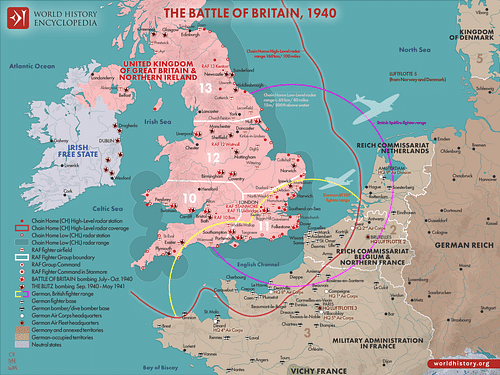
When flying to and from targets in Britain, He 111s, despite their several machine guns, proved to be vulnerable to attacks from enemy fighters like the Supermarine Spitfire and Hawker Hurricane. Consequently, He 111s and other bombers were protected by a fighter escort when possible, for example, a squadron of Messerschmitt BF 109s. Eventually, He 111s became so vulnerable to fighter attacks that their use was generally reduced to night activities.
The He 111s remained useful in less air-intensive theatres such as the Mediterranean, North Africa, and the Eastern Front. The He 111's main internal rival as the medium bomber of choice was the more antiquated Dornier Do 17, the slightly faster but vulnerable Dornier Do 215, and the smaller but faster Junkers Ju 88, which ultimately replaced it. The He 111's great strength remained its versatility, which made the aircraft suitable for multiple roles like reconnaissance, as a pathfinder, pulling gliders, carrying paratroops, mine laying at sea, and dropping supplies such as at the siege of Stalingrad in 1942-43. In total, around 7,000 He 111s were built for the Luftwaffe during the Second World War.

